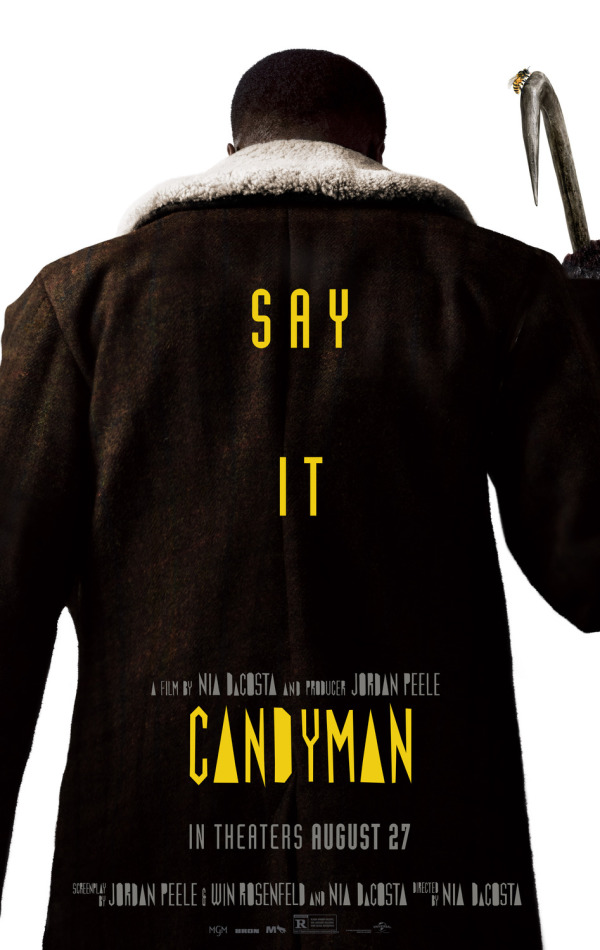CANDYMAN (Directed by Nia DaCosta, 91 minutes, 2021, USA)
![]() BY DAN TABOR FILM CRITIC No horror movie monster has as much socio-political bite as the titular demon in Candyman, Clive Barker’s riff on the Bloody Mary same-my-name trope. The first film in the series, 1992’s Candyman setup the franchise’s tragic origin myth, introducing us to Daniel Robitaille (Tony Todd), a late 19th Century artist and son of a slave killed by an angry mob when he fell in love with and fathered a child with the white daughter of a wealthy landowner. Daniel wasn’t simply lynched either, these things require both a tragic backstory and a horrific ending to propel them into the stuff of legend. After Daniel’s right hand was severed, he was then smeared with a honeycomb stolen from an apiary, and stung to death by bees. This horrific end kept his soul from resting and allowed him to live on and torment those who were foolish enough to summon him by saying his name five times in a mirror.
BY DAN TABOR FILM CRITIC No horror movie monster has as much socio-political bite as the titular demon in Candyman, Clive Barker’s riff on the Bloody Mary same-my-name trope. The first film in the series, 1992’s Candyman setup the franchise’s tragic origin myth, introducing us to Daniel Robitaille (Tony Todd), a late 19th Century artist and son of a slave killed by an angry mob when he fell in love with and fathered a child with the white daughter of a wealthy landowner. Daniel wasn’t simply lynched either, these things require both a tragic backstory and a horrific ending to propel them into the stuff of legend. After Daniel’s right hand was severed, he was then smeared with a honeycomb stolen from an apiary, and stung to death by bees. This horrific end kept his soul from resting and allowed him to live on and torment those who were foolish enough to summon him by saying his name five times in a mirror.
Candyman is set in 1992 and follows a white college student named Helen Lyle (Virgina Madsen), who is doing her thesis on urban legends and bears a striking resemblance to the woman Daniel Robitaille fell in love with. While investigating a series of deaths that are later attributed to a drug dealer in the Cabrini-Green housing projects show goes by the nickname Candyman, Helen eventually stumbles upon the real deal. From there Helen tumbles down this surreal rabbit hole where myth becomes reality, which takes a shocking toll on her sanity as she is blamed for a series of deaths she claims were perpetrated by the ghost of Daniel Robitaille, aka Candyman. The film has become part of the modern horror canon.
Twenty-nine years later, writer-producer Jordan Peele and director Nia DaCost have delivered a reboot that was worth the wait. The film functions as a direct sequel to the first film more or less, leaving behind any real mention of the other mediocre sequels to refocus the hooked avenger’s mythology into a much more socially relevant configuration. Set in now-gentrified Cabrini-Green circa now, the film’s protagonists are Anthony (Yahya Abdul-Mateen II) and Brianna (Teyonah Parris) a well todo black couple this time living in the newly posh neighborhood. The trouble begins when Anthony, a once-edgy visual artist who’s lately been accused of having lost the streetwise authenticity that made him a name commodity in the local art scene, decides to go poke around what’s left of the old housing project and, inevitably, leads him back to Candyman.
In Peele’s telling, Candyman has become a spell-casting incantation that allows black men who die in horrific and unjust ways to exact their vengeance on those foolish enough to Say His Name. This premise affords Peele the opportunity to tackle systemic racism, police brutality and poverty through a horror movie prism, as he did to great effect in Get Out. Aesthetically Peele’s reboot is very much inspired by the original, the cinematography features a similar stylistic approach composition and lighting, as well as the high contrast, drab color palette and the way the camera pans over the architecture of the Chicago cityscape transmuting it into an otherworldly hellscape. The atmospheric score completes the presentation by using heavy low frequency tones and bass to accentuate the scares and keep the audience in a perpetual state of unease. Yahya Abdul-Mateen II puts forth a real vulnerability on screen that allows the audience to latch onto him as a character. It’s a dynamic performance that is shockingly reminiscent of Virgina Madsen’s take in the original in how we are forced to watch helplessly as he goes from handsome and confident to unraveling at the seams. Teyonah Parris on the other hand offers an intense and understated take opposite Abdul-Mateen.
Candyman is flawless in its execution, hitting all the obligatory horror beats and imbueing its namesake with a renewed and relevant sense of purpose. Nia DaCosta and Peele have elevated Candyman and transformed him into a demon of vengeance, giving him a depth and social relevance absent in his machete wielding, hockey mask-wearing contemporaries. While the first film functioned as more of a twisted love story, this film is an exploration of the cyclical nature of violence in the black community. It’s a concept that may be a bit too abstract or heady for some, but is way more terrifying than a guy with a hook for a hand. Simply put Candyman is both a dense and brutal horror masterwork and a pitiless deconstruction of systemic racism in America that will no doubt be the subject of debate and discussion for years to come.

